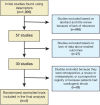Metaanalysis of Multivessel vs Culprit Artery Only Percutaneous Coronary Intervention in ST Elevation Myocardial Infarction
- PMID: 31258422
- PMCID: PMC6584205
- DOI: 10.31486/toj.18.0033
Metaanalysis of Multivessel vs Culprit Artery Only Percutaneous Coronary Intervention in ST Elevation Myocardial Infarction
Abstract
Background: Primary percutaneous coronary intervention (PCI) is the most frequently used treatment modality for patients presenting with ST elevation myocardial infarction (STEMI). Current professional society guidelines recommend culprit artery only PCI. Recent evidence suggests the potential benefit of multivessel PCI among patients with STEMI that is not complicated by cardiogenic shock. Methods: We systematically searched PubMed, EMBASE, and the Cochrane Central Register of Controlled Trials for clinical studies of patients with STEMI, not complicated by cardiogenic shock, who underwent primary PCI between January 1966 and January 2018. We evaluated all-cause and cardiovascular mortality, reinfarction, and repeat revascularization among patients randomized to a multivessel PCI strategy compared to a culprit artery only PCI strategy. Results: Four randomized clinical trials with a total of 1,044 patients met the inclusion criteria. Five hundred and sixty-six patients underwent multivessel PCI, and 478 patients underwent culprit artery only PCI. Multivessel PCI reduced all the studied endpoints: total death, cardiac death, reinfarction, and repeat revascularization (all P values <0.05). Conclusion: To our knowledge, this is the largest metaanalysis of randomized controlled trials studying multivessel PCI vs culprit artery only PCI in STEMI patients without shock, among whom lesion severity was graded by angiography alone. We found that compared to culprit artery only PCI, the multivessel PCI strategy was beneficial in reducing all-cause and cardiovascular mortality, reinfarction, and the need for repeat revascularization.
Keywords: Coronary artery disease; ST elevation myocardial infarction; mortality; myocardial revascularization; percutaneous coronary intervention.
Figures





Similar articles
-
Meta-Analysis and Trial Sequential Analysis of Randomized Controlled Trials for Multivessel PCI Versus Culprit Artery Only PCI in STEMI Without Cardiogenic Shock.Curr Probl Cardiol. 2021 Mar;46(3):100646. doi: 10.1016/j.cpcardiol.2020.100646. Epub 2020 Jun 13. Curr Probl Cardiol. 2021. PMID: 32650950 Review.
-
Multivessel Versus Culprit-Only Revascularization in STEMI and Multivessel Coronary Artery Disease: Meta-Analysis of Randomized Trials.JACC Cardiovasc Interv. 2020 Jul 13;13(13):1571-1582. doi: 10.1016/j.jcin.2020.04.055. JACC Cardiovasc Interv. 2020. PMID: 32646699
-
Multivessel versus culprit-only PCI in STEMI patients with multivessel disease: meta-analysis of randomized controlled trials.Clin Res Cardiol. 2020 Nov;109(11):1381-1391. doi: 10.1007/s00392-020-01637-6. Epub 2020 Apr 1. Clin Res Cardiol. 2020. PMID: 32239284 Free PMC article. Review.
-
Multivessel Percutaneous Coronary Intervention in Patients With ST-Segment Elevation Myocardial Infarction With Cardiogenic Shock.J Am Coll Cardiol. 2018 Feb 27;71(8):844-856. doi: 10.1016/j.jacc.2017.12.028. J Am Coll Cardiol. 2018. PMID: 29471935
-
Culprit Vessel-Only Versus Multivessel Percutaneous Coronary Intervention in Patients With Cardiogenic Shock Complicating ST-Segment-Elevation Myocardial Infarction: A Collaborative Meta-Analysis.Circ Cardiovasc Interv. 2017 Nov;10(11):e005582. doi: 10.1161/CIRCINTERVENTIONS.117.005582. Circ Cardiovasc Interv. 2017. PMID: 29146672 Review.
Cited by
-
Multivessel versus Culprit-Only Revascularization Strategies in Cardiac Arrest Survivors.Acta Cardiol Sin. 2022 Mar;38(2):175-186. doi: 10.6515/ACS.202203_38(2).20211107A. Acta Cardiol Sin. 2022. PMID: 35273439 Free PMC article.
-
Multi-vessel Versus Culprit-vessel-only PCI for STEMI: Where Does the Jury Stand?Ann Med Surg (Lond). 2021 Apr 24;65:102343. doi: 10.1016/j.amsu.2021.102343. eCollection 2021 May. Ann Med Surg (Lond). 2021. PMID: 33996070 Free PMC article. No abstract available.
References
-
- American College of Emergency Physicians; Society for Cardiovascular Angiography and Interventions, O'Gara PT, Kushner FG, Ascheim DD, et al. 2013 ACCF/AHA guideline for the management of ST-elevation myocardial infarction: a report of the American College of Cardiology Foundation/American Heart Association Task Force on Practice Guidelines. J Am Coll Cardiol. 2013. Jan 29;61(4):e78-e140. doi: 10.1016/j.jacc.2012.11.019. - DOI - PubMed
-
- Kristensen SD, Laut KG, Fajadet J, et al; European Association for Percutaneous Cardiovascular Interventions. Reperfusion therapy for ST elevation acute myocardial infarction 2010/2011: current status in 37 ESC countries. Eur Heart J. 2014. Aug 1;35(29):1957-1970. doi: 10.1093/eurheartj/eht529. - DOI - PubMed
-
- Bataille Y, Déry JP, Larose E, et al. . Prevalence, predictors and clinical impact of unique and multiple chronic total occlusion in non-infarct-related artery in patients presenting with ST-elevation myocardial infarction. Heart. 2012. December;98(23):1732-1737. doi: 10.1136/heartjnl-2012-302376. - DOI - PubMed
LinkOut - more resources
Full Text Sources
Miscellaneous
